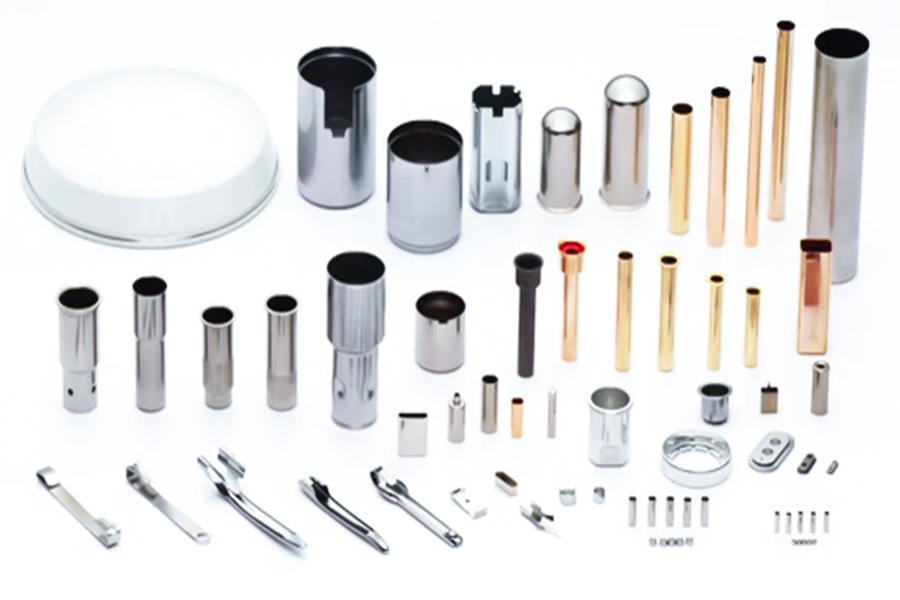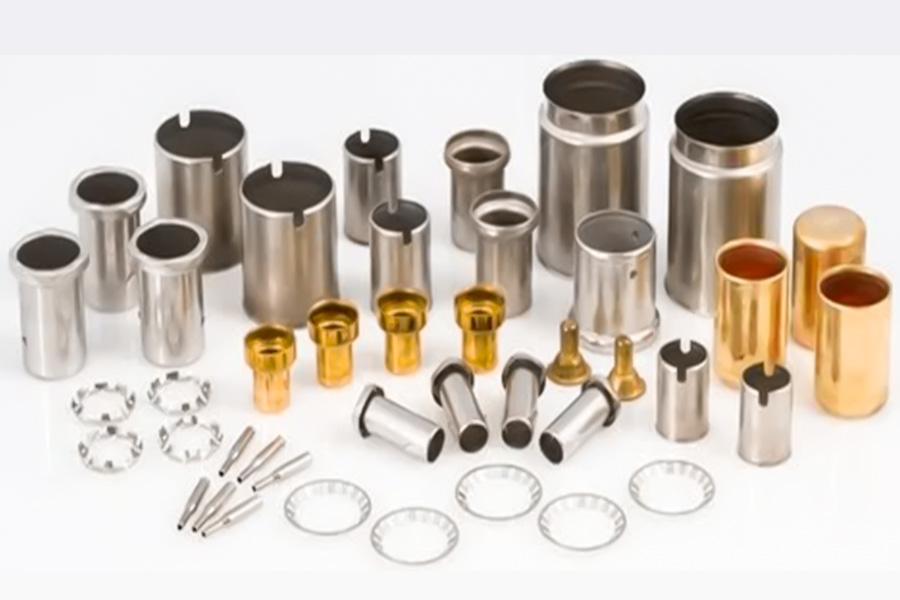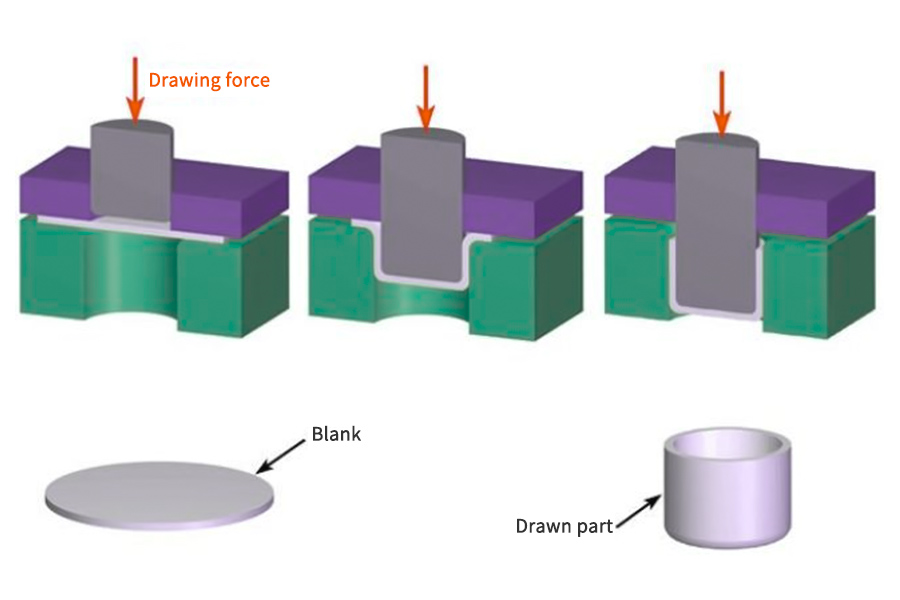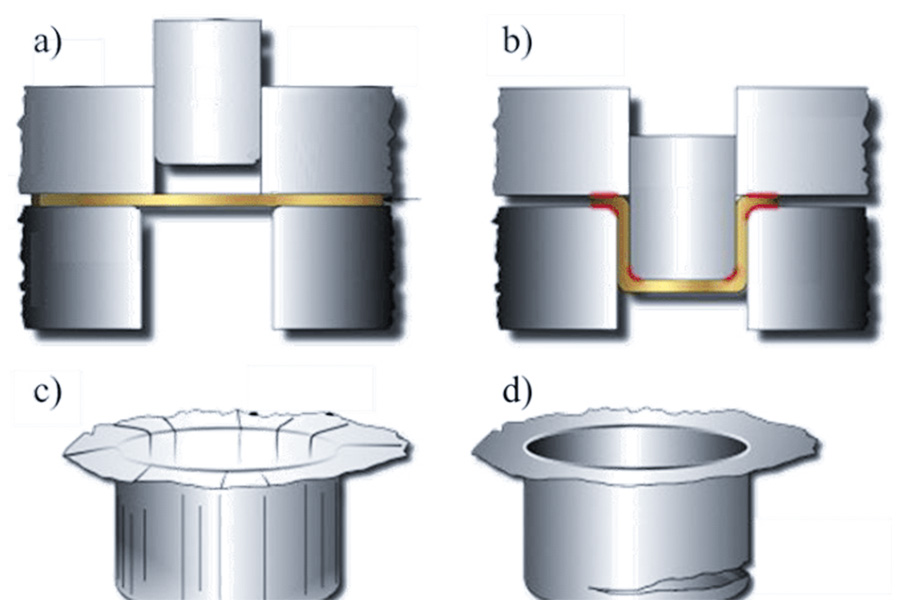Deep drawing stamping, as an important method in metal forming process, is widely used in automobile, aerospace, home appliances, electronics and other industries. It applies external force to the flat metal material through the mold to cause it to plastically deform, thereby forming a hollow part with a specific shape and size. The success of this process depends largely on the materials chosen. So, what materials are used for deep drawing stamping? Next, theLS teamwill take everyone to explore thetypes of materials used in deep drawing stampingand the characteristics of these materials.
What is deep draw stamping?
Deep drawing stampingis a professional deep drawing forming technology that can process flat metal materials into seamless and hollow shapes. Different from other metal forming processes, thedeep drawing stamping process guidesthe metal into the mold cavity and deforms it in a plastic state, thereby creating durable and high-precision bottom closed parts, such as cylinders or various shapes. Different cup-shaped parts. This efficient and precise manufacturing process plays a vital role in many industries, especially those that require extremely high component strength and precision.

What Materials Are Used in deep draw stamping?
Deep drawing stamping is an importantmetal forming process that is widely used in many industries. The following materials are commonly used for deep drawing stamping, along with their characteristics and applications:
1. Mild steel
- Features:Low carbon steelis carbon steel with a carbon content of less than 0.25%. It has good plasticity and toughness and is easy to process and form. At the same time, low carbon steel also has a certain strength and weight ratio, as well as good welding properties.
- Application:Because low carbon steel is easy to form and relatively low cost, it iswidely used in the manufacture of automobile bodies, home appliance casings, engineering structural parts, etc. In addition, low carbon steel is often used in deep-drawn products, such as car cabs, engine hoods, etc.
2. Stainless steel
- Features:Stainless steel is an iron alloy containing at least 10.5% chromium and has good oxidation and corrosion resistance. Stainless steel has high strength and is not easy to rust, so it has a long service life.
- Applications:Stainless steel is often used to manufacture products that require high corrosion resistance, such asmedical devices, food processing equipment, household appliances, etc. In addition, stainless steel is also widely used in building shells, industrial ships and other fields.
3. Aluminum
- Features:Aluminum is a lightweight metalwith a density about 1/3 that of mild steel and has good ductility and corrosion resistance. Aluminum also has good thermal and electrical conductivity and is easy to process and shape.
- Applications:Due to aluminum's lightweight and corrosion-resistant properties, it is often used in the manufacture of lightweight automotive components, aerospace vehicles, radiators, energy storage devices (such as batteries), etc. In addition, aluminum is also widely used in beverage containers, pharmaceutical industry and other fields.
4. Copper
- Features:Copper has good electricaland thermal conductivity and is an ideal material in the electronics and electrical fields. At the same time, copper also has certain ductility and corrosion resistance, and is easy to process and shape.
- Application:Copper is commonly used in the manufacture of electronic components such as connectors and terminals, as well as electrical products such as switches and sockets. In addition, copper is also used to manufacture wiring harnesses, sensors and other components in automobiles. Copper is also one of the preferred materials where good conductivity and aesthetics are required.
5. Nickel alloy
- Features:Nickel alloy has good corrosion resistance, high temperature strength and processability. Nickel alloys can maintain stable performance in harsh environments and have good mechanical and physical properties.
- Applications:Nickel alloys are commonly used to manufacture complex components in aerospace, nuclear energy, petroleum industries and other fields. Because nickel alloys have excellent corrosion resistance and high-temperature strength, they are also often used in the manufacture of chemical equipment, marine engineering, and other applications that require high corrosion resistance and high-temperature strength.

Why is deep drawing stamping so popular among manufacturers?
Thepopularity of deep drawing stampingamong manufacturers is mainly due to its many advantages, which make deep drawing stamping an indispensable part of modern manufacturing. The reasons why deep drawing stamping is popular are:
- High quality products:The deep-drawn stamping parts are made and assisted by molds in the processing process, so the shape and size of the processed products are very accurate. The service life of the die is long, and the deep-drawn stamping parts produced are high-end products in the market.
- Wide range of applications:Deep drawn stamping parts are available in a variety of sizes and are precise in size, which can be applied to many fields of life and industrial production, such as household appliances and automobile manufacturing.
- The production process is simple and easy:From the perspective of the overall control of the process, each step of the production process of deep-drawn stamping parts is controlled like an assembly line, so the complexity of human operation is much simpler than ordinary stamping methods.
- Superior performance:Deep-drawn stamping parts have good performance in terms of tightness and internal strength, which can meet the needs of high-quality products.
- Energy saving and environmental protection:Deep drawing stamping parts have a special manufacturing process, and many materials will be reasonably used in the processing process, and do not require too much energy consumption, saving energy and reducing production costs.

What is the difference between deep drawing stamping and other technologies?
Compared with other metal forming technologies, deep drawing stamping has the following main differences:
| Name of the technology | Deep drawing and stamping | foundry | forging | stamping |
|---|---|---|---|---|
| Basic principle | The metal sheet is pulled radially into the forming mold by using the mold to form a three-dimensional shape | The molten metal is poured into a mold, cooled and solidified | Uses impact or pressure to deform metal | An external force is applied to the sheet metal through the mold, resulting in plastic deformation |
| Type of material | Sheet metal, such as stainless steel, aluminum alloy, etc | Various metal materials, including cast iron, cast steel, etc | Various metal materials, such as carbon steel, alloy steel, etc | Sheet metal, strip, pipe, etc |
| Part shape | Deep and hollow shapes such as fuel tanks, mufflers, etc | Complex shapes, but may have low accuracy and surface quality | The shape and size can be customized with high precision | Various shapes, but limited depth |
| Accuracy and surface quality | High precision, good surface quality, usually without the need for post-processing | Medium precision, surface quality requires post-processing | High precision, good surface quality | Precision and surface quality depend on the mold and process |
| Material utilization | Higher, less scrap | Low, often produce gates, risers and other waste | Higher, but affected by the forging process | Depends on the stamping process and die design |
| Productivity | Taller, suitable for high-volume production | Depending on the casting method and equipment, it is usually lower | Medium to high, depending on the forging process and equipment | Higher, suitable for mass production |
What are the common defects of deep drawing stamping?
Common defects in deep drawing stampingmainly include the following:
1.Crack
- Cause:This is one of the most common defects in the deep drawing stamping process. It usually occurs in areas where the material is subject to excessive tension or deformation, such as near the punch fillet or the die opening. Rupture may be caused by insufficient material strength, unreasonablemold design, improper stamping process parameters, or poor lubrication.
- Solution:Increase the mold fillet radius to reduce stress concentration.Reduce the drawing depthto ensure it is within the tolerance of the material. Adjust the blank holder force to avoid material rupture caused by excessive force. Choose materials with higher tensile strength and finer grains.
2.Wrinkling
- Cause:Wrinkling is caused by uneven tension and pressure on the material during the stamping process, resulting in local material accumulation and instability. Wrinkling usually occurs on flange portions or areas where material flows faster. Wrinkling not only affects the aesthetics of the part, it may also affect its functionality and fitability.
- Solution:Increase the blank holder force to ensure that the material flows evenly during the stretching process. Adjust the mold gap to match the material thickness.Reduce draw depth to avoid material buildup.
3.Springback
- Cause:Springback is the shape change of deep-drawn stamped parts due to the elastic recovery of the material after unloading. Springback can cause part dimensions to be inaccurate, shape distortion, or assembly difficulties. The size of springback depends on factors such as the material's elastic modulus, thickness, forming depth, and mold design.
- Solution:Optimize the mold design and adjust parameters such as the gap between the convex and concave molds and the cutting edge radius according to product requirements and material properties. Choose materials with a smaller elastic modulus to reduce springback. Adjust molding conditions, such as increasing pressure, reducing speed, controlling temperature, etc., to improve the deformation process and stress distribution of the material.

FAQs
1.What materials are used in deep drawing?
Commonly used materials for deep drawing include mild steel, stainless steel, aluminum, copper, titanium alloys, and nickel-chromium alloys. The choice of these materials often depends on the intended use of the finished product, as each metal has its own unique properties that may be advantageous in specific situations.
2.What materials are used for stamping?
Stamping processes also typically use materials such as metal sheets, strips, and pipes. The selection of these materials also depends on the intended use and performance requirements of the finished product. Common stamping materials include mild steel, stainless steel, aluminum alloy, etc.
3.What metals are suitable for deep drawing operations?
Metals suitable for deep drawing operations generally have good ductility and plasticity, allowing them to be stretched into the desired shape without cracking. The above-mentioned low carbon steel, stainless steel, aluminum, copper, titanium alloy and nickel-chromium alloy are all metals suitable for deep drawing operations.
4.What are the steps in the deep drawing and stamping process?
The process flow of deep drawing stamping usually includes: Blanking: The material is separated along the closed contour. The separated parts are mostly flat process parts or cylindrical parts with a height less than 20mm. Stretching: Transforming a flat or cylindrical process piece into an open hollow piece, the wall thickness may or may not change. Subsequent processing: may include fine drawing (further thinning and stretching the stretched hollow part, and increasing the height to obtain a part with a bottom thickness greater than the side wall), punching (separating the waste material from the product along the closed contour line, thereby Steps such as obtaining the required holes on the workpiece), cutting (using a die to trim the edges of the product to make it a component with a certain shape and size).
Summary
There are many types ofmaterials used in deep drawing stamping, and each material has its own unique properties and application range. When selecting, multiple factors such as product performance requirements, cost-effectiveness, and process conditions need to be comprehensively considered. Through reasonable material selection and process optimization, high-quality deep drawing forming can be achieved, providing strong support for the development of related industries.
Disclaimer
The content on this page is for reference only.LSdoes not make any express or implied representation or warranty as to the accuracy, completeness or validity of the information. No performance parameters, geometric tolerances, specific design features, material quality and type or workmanship should be inferred as to what a third party supplier or manufacturer will deliver through the Longsheng Network. It is the responsibility of the buyerseeking a quote for partsto determine the specific requirements for those parts.Pleasecontact usfor moreinformation.
LS Team
LS is an industry-leading companyspecializing in custom manufacturing solutions. With over 20 years of experience serving more than 5,000 clients, we focus on high-precisionCNC machining,sheet metal fabrication,3D printing,injection molding,metal stamping,and other one-stop manufacturing services.
Our factory is equipped with more than 100 advanced 5-axis machining centers and is ISO 9001:2015 certified. We provide fast, efficient, and high-quality manufacturing solutions to customers in over 150 countries worldwide. Whether it’s low-volume production or large-scale customization, we can meet your needs with delivery as fast as 24 hours. ChoosingLS Technologymeans choosing efficiency, quality, and professionalism.
To learn more, please visit our website:www.lsrpf.com






